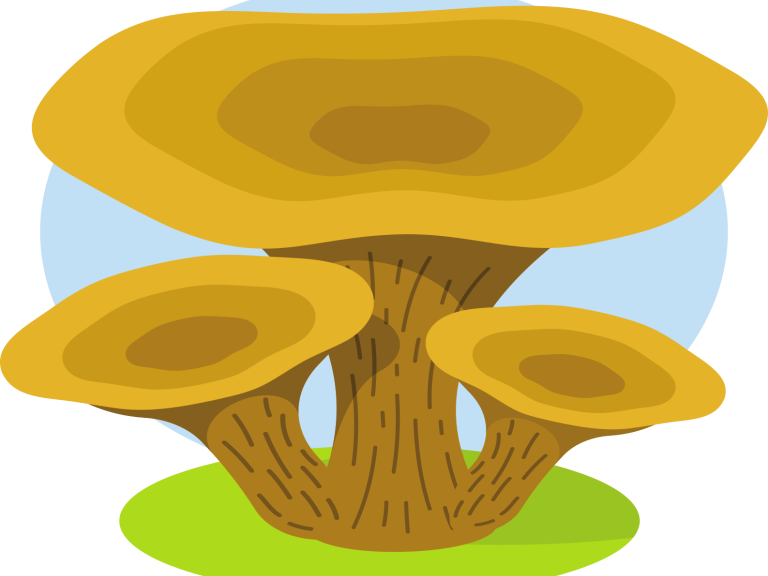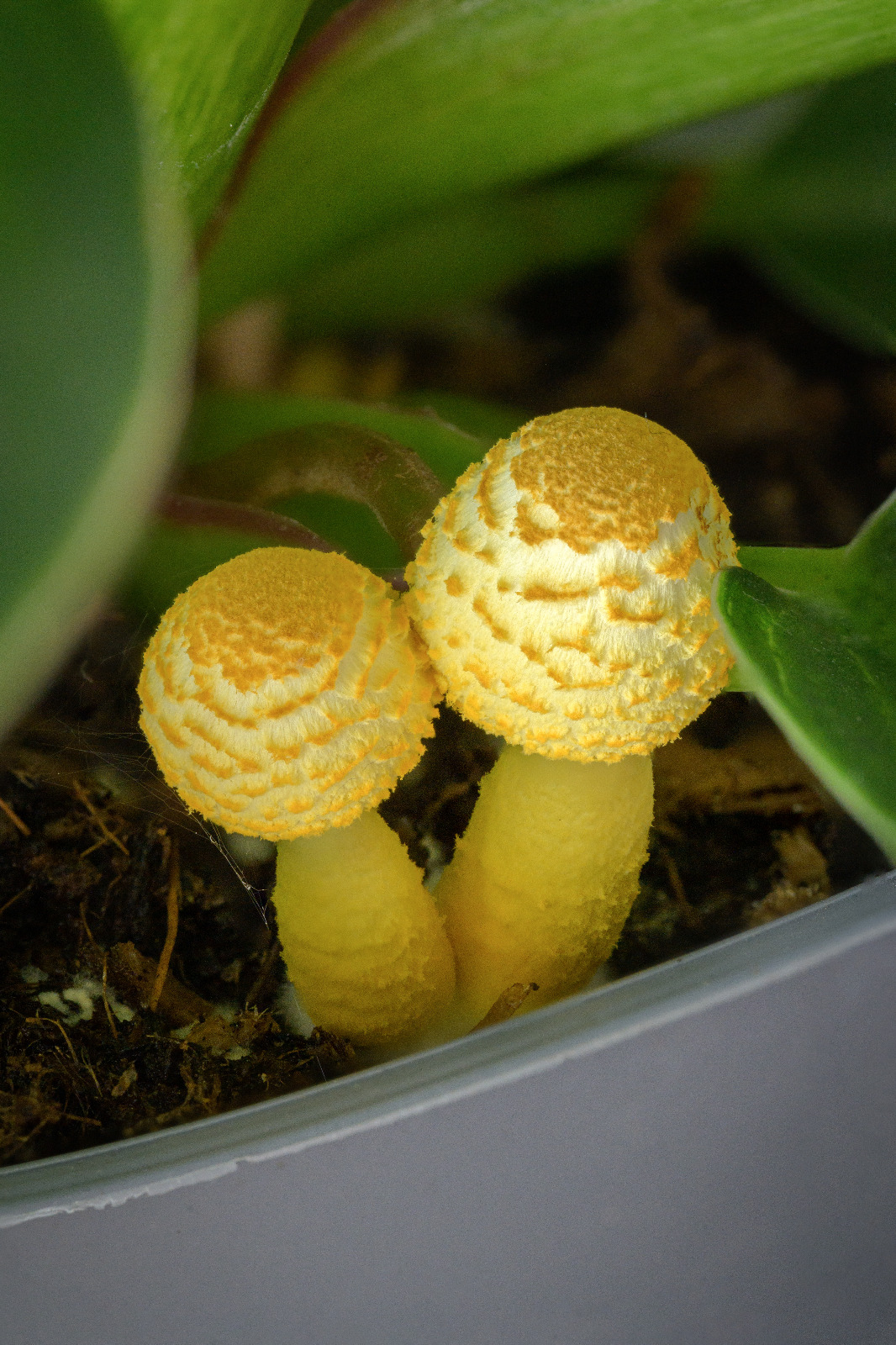Leucocoprinus birnbaumii: A small mushroom goes around the world.

Evidently, working on arbuscular mycorrhizal fungi makes you a “mushroom expert”. So, it shouldn’t come as a surprise when your friends and family send you occasional pictures of various mushrooms with an identification request. If this mushroom sprouts in a garden bed or pot plant, this is commonly followed by the question, "are they bad for the plants"? Mostly, they will send photos of the same mushroom species repeatedly.
That mushroom is Leucocoprinus birnbaumii, also known as the plantpot dapperling or flowerpot parasol. These common names are an excellent description of its “habitat”. Outside of tropical areas, this mushroom is commonly found growing next to pot plants, in greenhouses or in garden beds. While its appearance might come as a surprise for some people, it is nothing to worry about. In fact, this mushroom is part of your very own plant pot ecosystem.
 Leucocoprinus birnbaumii fruiting bodies emerging from inside a plant pot.
Leucocoprinus birnbaumii fruiting bodies emerging from inside a plant pot.
Its scientific name is derived from its first description in Europe, when in 1839, the Czech mycologist August Corda named this species after a garden inspector called Birnbaum, who discovered it growing in a greenhouse.
Personally, I’m a big fan of the good old birnbaumii. It is a beautiful mushroom with a very understandable life cycle and biology. The global use of potting mixes led to its widespread distribution to almost every household around the world. However, it is not considered an invasive species because it does not get overpopulated in natural ecosystems, and it doesn’t negatively change the environment. It is just your friendly yellow mushroom that stops by and wants to say hello.
The rise of L. birnbaumii is connected to the global use of potting mix and soilless plant substrates for pot plants, greenhouses and gardens. As mentioned in my other article, a major constituent of potting mix is peat moss, which is a superb source of carbon. Other components of potting mix, such as wood chips, are equally high in carbon. Common potting mixes are comprised of 15-25% carbon, which is far more than what is found in natural soils (approx. 0.5-5%). Luckily, L. birnbaumii is a saprophytic fungus. This means that our little friend is wonderful at using decayed organic matter (carbon) as an energy source. In fact, it is so good that it could be considered as a niche species for nursery plants. You might even say that this mushroom is specially adapted to living in carbon-rich potting mixes, which explains its global occurrence.
Once the fungus makes its way into a plant nursery, a single fruit body can produce enough spores to inoculate all surrounding pots. While I couldn’t find a spore count for our L. birnbaumii, one button mushroom (which is in the same family) produces 1.36 billion spores. That’s plenty of spores to inoculate a whole greenhouse! From there, the mushroom travels into households as mycelium. Once the mycelium reaches a certain size with the optimum temperature and humidity, it will produce fruiting bodies. If the pot plant dies prematurely, the fungus might get re-introduced into the system via green waste composting. Theoretically, green waste composting should disable mycelium and spores of L. birnbaumii. Commonly, national guidelines require hot composting periods of 50 °C for a couple of days. This, however, might not always be fulfilled in practice.
The appearance of L. birnbaumii in plant pots is completely harmless. Because the mushroom is saprophytic, it does not directly interact with the plant, as is the case with symbiotic or parasitic fungi. Some saprophytic fungi might show overachieving traits and feast on living plants, which can make them a pest, too. This, however, has not been reported here. Instead, L. birnbaumii focuses on soil organic matter (carbon) and helps to break down stable soil aggregates, releasing plant-nutrients. The effects of this mushroom on plant growth have, to my knowledge, not been researched. But it might even be a positive relationship, making it a beneficial microorganism. This, however, is speculative. But we know of other mushrooms, such as the oyster mushroom, that they can help eliminate unwanted nematodes. Maybe the plantpot dapperling has similar functional traits? At least, its ability to decompose organic matter could provide a plant growth boost.
Besides dwelling in plant nurseries, this mushroom does not appear to have other direct benefits for mankind. There are no records of it being used in native cultures. Unlike some “vitality mushrooms”, such as Reishi or Shiitake, it does not provide medicinal benefits. It definitely doesn’t make you high either. Instead, the consumption of L. birnbaumii could give a person gastric ulcers. This is because of the unique compounds which also give it the bright yellow colour. These compounds have been named Birnbaumin A and B. In fact, they contain some unusual structures which make them at least interesting for a small subgroup of organic chemists.
Nature can sometimes be overwhelming. Some fungi have difficult reproduction cycles, which involve various hosts and different reproductive structures. When trying to cultivate certain fungi, growers are met with many challenges, such as creating the right substrates (e.g., shiitake) or finding suitable host plants (e.g., truffles). But our little plantpot dapperling is different. Based on our current understanding, it is a useful decomposer and important in the carbon and nutrient cycling of soils. But it is not a mushroom that is currently threatened. Nobody tries to cultivate this mushroom, and it just appears by itself in our households. What could be considered an invasive trait is relatively harmless, because it does not overtake natural ecosystems. In conclusion, it is just a friendly yellow mushroom that stops by our households to say hello.